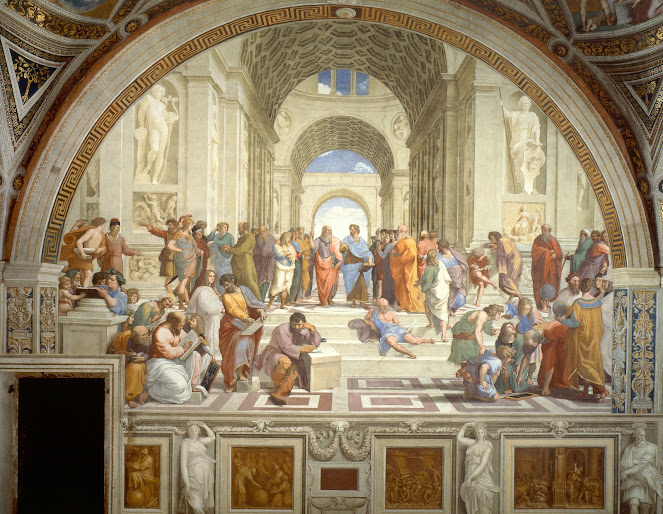Renaissance Blog
Art Analysis of The School of Athens
Raphael's fresco, The School of Athens, captures many of the essential aspects of the Italian Renaissance art style. The perspective and foreshortening of the fresco are used to bring the viewer's gaze to the main point of the art piece: Plato and Aristotle. Sfumato is also used all over the painting to aid the foreshortening in creating the illusion of a three-dimensional space on a flat wall.
The School of Athens is one of a set of four frescos that were created to represent the "four branches" of knowledge. Fittingly, The School of Athens is the fresco that represents the branch of philosophical knowledge.
This painting is related particularly closely to the Catholic reinvention of Rome. The School of Athens was painted as a fresco directly onto a well in the Vatican Palace. Raphael was commissioned by Pope Julius II, who was famous for his vision for Rome and his patronage of the arts in pursuit of that vision. Pope Julius II wanted to support works of art that would outdo even the older artworks in Rome at the time.
I think this painting accomplishes many things all at once and it does so with great beauty and elegance in form. The first concept that comes to my attention when viewing this painting is the centerpiece and what flows out from the centerpiece. The centerpiece, placed directly in front of the vanishing point of the painting, features Plato and Aristotle debating underneath an archway that leads to the outside world. To me, this framing represents a couple of things.
Firstly, it is that the outside world is the source of all the light in the room coming in through the archway. I interpret this light to represent knowledge, and therefore the painting is showing that nature illuminates humanity by providing a raw form of interpretable knowledge.
The interpretation of the raw knowledge nature provides comes from the second part of the centerpiece, Aristotle and Plato. Each philosopher holds a different basic interpretation of the light (knowledge) flowing into the room. Aristotle holds a more materialistic view while Plato holds a more spiritual view of the world. Despite separate interpretations, this knowledge flows out from them into the rest of the thinkers in the room.
The painting also serves as a history lesson in philosophical thought. Each side of the painting (split down the middle) represents either thoughts based more or less on Plato's philosophy or on Aristotle's philosophy. Aristotle's side features realist thinkers such as Alexander the Great and Diogenes, while Plato's side features idealists like Pythagoras. Each side of the room gives a condensed compilation of significant historical European philosophers.
Works Cited
Kühner, Hans. “Julius II.” Encyclopædia Britannica, Encyclopædia Britannica, Inc., www.britannica.com/biography/Julius-II.
“School of Athens.” Encyclopædia Britannica, Encyclopædia Britannica, Inc., 17 May 2023, www.britannica.com/topic/School-of-Athens.
Stewart, Jessica. “The Story behind Raphael’s Masterpiece ‘The School of Athens.’” My Modern Met, 1 May 2023, mymodernmet.com/school-of-athens-raphael/.
Zucker, Dr. Steven, and Dr. Beth Harris. “Raphael, School of Athens.” Smarthistory, smarthistory.org/raphael-school-of-athens/.






Your analysis is so in-depth and really made me think about this artwork. I love how you showed the direction of light and intentional depiction of knowledge as light. I don't think I could have deciphered this by myself! Very impressive! To me, this art style seems to be very Humanistic and classic Renaissance art. I love how each person is wearing an elegant, colorful robe. I think it really emphasizes the light in the painting as well.
ReplyDelete